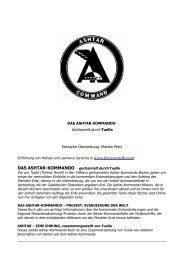ALIEN INTERVIEW - THE NEW EARTH - Earth Changes and The ...
ALIEN INTERVIEW - THE NEW EARTH - Earth Changes and The ...
ALIEN INTERVIEW - THE NEW EARTH - Earth Changes and The ...
Create successful ePaper yourself
Turn your PDF publications into a flip-book with our unique Google optimized e-Paper software.
Albert Einstein. <strong>The</strong> Einstein-Hapgood correspondence is a forgotten page in the history of<br />
science. Rose <strong>and</strong> I obtained these letters (ten from Einstein to Hapgood) from Albert<br />
Einstein's Archives in the Fall of 1995. <strong>The</strong>y show, for the first time, just how extensively<br />
Albert Einstein was involved in assisting Charles Hapgood in the development of the theory.<br />
This correspondence is detailed in <strong>The</strong> Atlantis Blueprint. Here is a brief summary:<br />
In his second reply (24 November 1952) to Hapgood, Einstein wrote that the idea of earth<br />
crust displacement should not be ruled out "apriori" just because it didn't fit with what we<br />
wanted to believe about the earth's past. What was needed, Einstein claimed, was solid<br />
"geological <strong>and</strong> paleontological facts."<br />
For six months, Hapgood gathered geological evidence to support the idea of an earth crust<br />
displacement. On the 3rd of May 1953 he forwarded thirty-eight pages of this evidence to<br />
Einstein. Central to his argument was Hapgood's evidence that Lesser Antarctica was icefree<br />
at the same time that North America lay smothered in ice. Einstein responded (8 May<br />
1953):<br />
"I find your arguments very impressive <strong>and</strong> have the impression that your hypothesis is<br />
correct. One can hardly doubt that significant shifts of the crust have taken place repeatedly<br />
<strong>and</strong> within a short time."<br />
He urged Hapgood to follow up on evidence of "earth fractures". A month later<br />
(11 June 1953) Hapgood sent Einstein forty-two pages of evidence on earth fractures <strong>and</strong><br />
the evolution of the ice sheets.<br />
Einstein wrote (17 December 1953) Hapgood urging him to address the "centrifugal<br />
momentum" problem. Hapgood responded with four pages on this problem <strong>and</strong> thirty-seven<br />
pages of "paleontological evidence" including the frozen mammoths of Arctic Siberia.<br />
Einstein was now convinced. On the 18th of May 1954, Einstein wrote a very favorable<br />
foreword for Hapgood's book <strong>EARTH</strong>'S SHIFTING CRUST: A KEY TO SOME BASIC<br />
PROBLEMS OF <strong>EARTH</strong> SCIENCE (published in 1958 by Pantheon Books, New York). <strong>The</strong><br />
Foreword begins:<br />
"I frequently receive communications from people who wish to consult me concerning their<br />
unpublished ideas. It goes without saying that these ideas are very seldom possessed of<br />
scientific validity. <strong>The</strong> very first communication, however, that I received from Mr. Hapgood<br />
electrified me. His idea is original, of great simplicity, <strong>and</strong> - if it continues to prove itself of<br />
great importance to everything that is related to the history of the earth's surface. ... I think<br />
that this rather astonishing, even fascinating, idea deserves the serious attention of anyone<br />
who concerns himself with the theory of the earth's development."<br />
-- Reference: When the Sky Fell, R<strong>and</strong> <strong>and</strong> Rose Flemth-Ath<br />
140 "<strong>The</strong> alignment of the Pyramids of Giza on the ground matches perfectly the<br />
alignment of the constellation of Orion as seen in the sky from Giza...".<br />
"(Robert) Bauval is specifically known for the Orion Correlation <strong>The</strong>ory (OCT). This proposes<br />
a relationship between the fourth dynasty Egyptian pyramids of the Giza Plateau <strong>and</strong> the<br />
alignment of certain stars in the constellation of Orion.<br />
One night, while working in Saudi Arabia, he took his family <strong>and</strong> a friend's family up into the<br />
s<strong>and</strong> dunes of the Arabian desert for a camping expedition. His friend pointed out Orion, <strong>and</strong><br />
mentioned that Mintaka, the smaller more easterly of the stars making up Orion's belt was<br />
253





